Case Study Analysis on Negotiations in Organizations
VerifiedAdded on 2023/04/22
|6
|1465
|418
AI Summary
This case study analysis discusses negotiations between an employee and a manager for salary hike. It covers the parties involved, their interests, power positions, emotions, and more. The study concludes with suggestions for improving negotiations. The document type is a case study analysis, and the type of assignment is not mentioned. The subject, course code, course name, and college/university are not mentioned either.
Contribute Materials
Your contribution can guide someone’s learning journey. Share your
documents today.
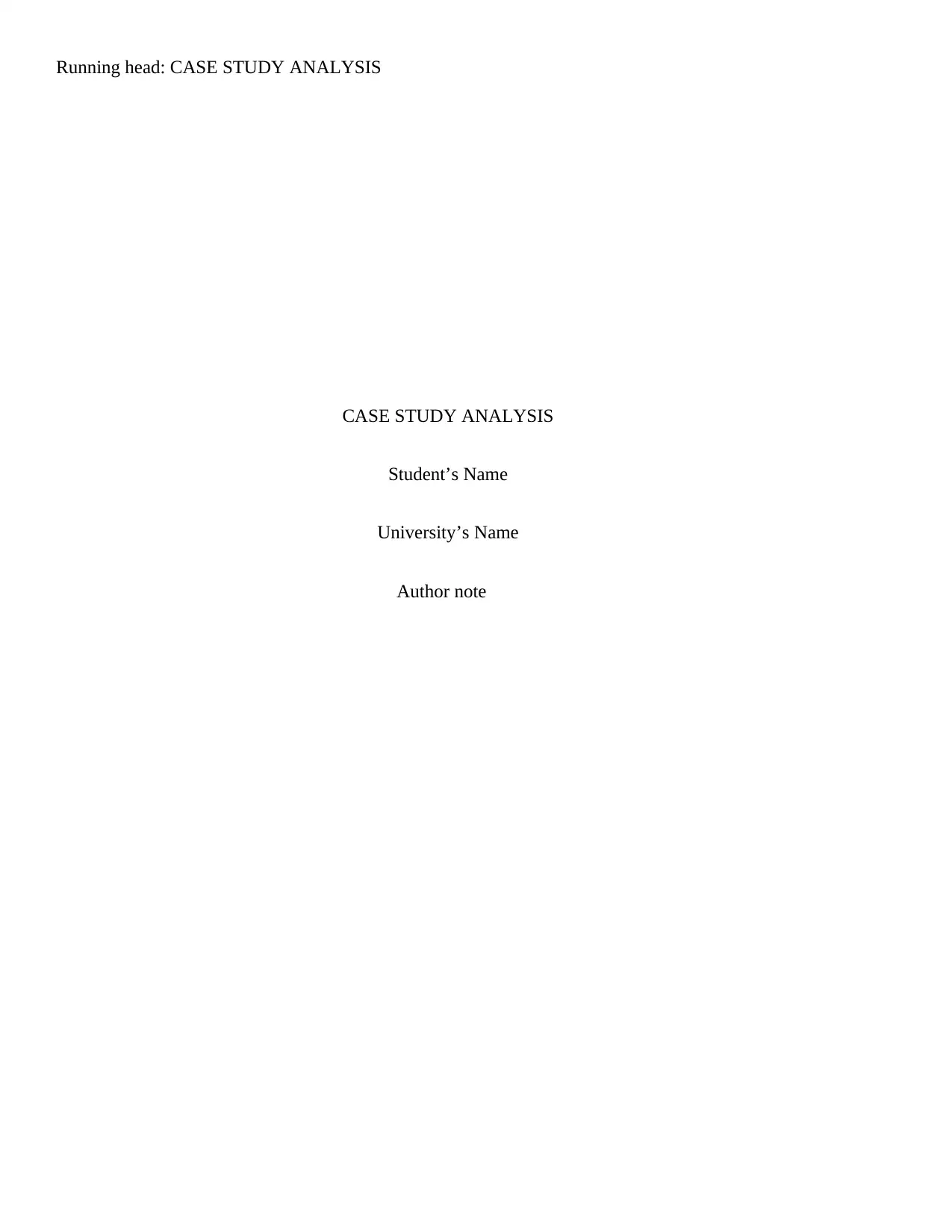
Running head: CASE STUDY ANALYSIS
CASE STUDY ANALYSIS
Student’s Name
University’s Name
Author note
CASE STUDY ANALYSIS
Student’s Name
University’s Name
Author note
Secure Best Marks with AI Grader
Need help grading? Try our AI Grader for instant feedback on your assignments.
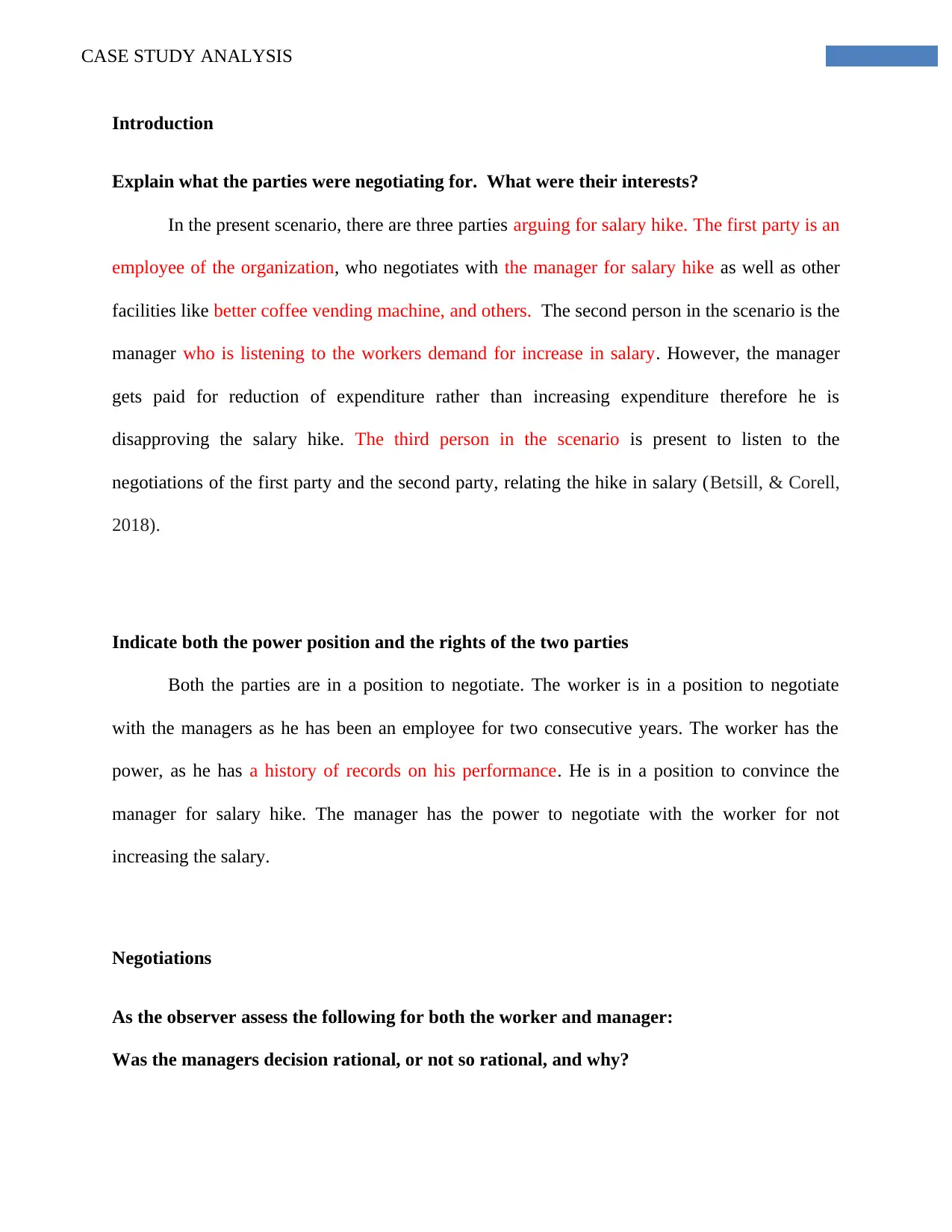
CASE STUDY ANALYSIS
Introduction
Explain what the parties were negotiating for. What were their interests?
In the present scenario, there are three parties arguing for salary hike. The first party is an
employee of the organization, who negotiates with the manager for salary hike as well as other
facilities like better coffee vending machine, and others. The second person in the scenario is the
manager who is listening to the workers demand for increase in salary. However, the manager
gets paid for reduction of expenditure rather than increasing expenditure therefore he is
disapproving the salary hike. The third person in the scenario is present to listen to the
negotiations of the first party and the second party, relating the hike in salary (Betsill, & Corell,
2018).
Indicate both the power position and the rights of the two parties
Both the parties are in a position to negotiate. The worker is in a position to negotiate
with the managers as he has been an employee for two consecutive years. The worker has the
power, as he has a history of records on his performance. He is in a position to convince the
manager for salary hike. The manager has the power to negotiate with the worker for not
increasing the salary.
Negotiations
As the observer assess the following for both the worker and manager:
Was the managers decision rational, or not so rational, and why?
Introduction
Explain what the parties were negotiating for. What were their interests?
In the present scenario, there are three parties arguing for salary hike. The first party is an
employee of the organization, who negotiates with the manager for salary hike as well as other
facilities like better coffee vending machine, and others. The second person in the scenario is the
manager who is listening to the workers demand for increase in salary. However, the manager
gets paid for reduction of expenditure rather than increasing expenditure therefore he is
disapproving the salary hike. The third person in the scenario is present to listen to the
negotiations of the first party and the second party, relating the hike in salary (Betsill, & Corell,
2018).
Indicate both the power position and the rights of the two parties
Both the parties are in a position to negotiate. The worker is in a position to negotiate
with the managers as he has been an employee for two consecutive years. The worker has the
power, as he has a history of records on his performance. He is in a position to convince the
manager for salary hike. The manager has the power to negotiate with the worker for not
increasing the salary.
Negotiations
As the observer assess the following for both the worker and manager:
Was the managers decision rational, or not so rational, and why?
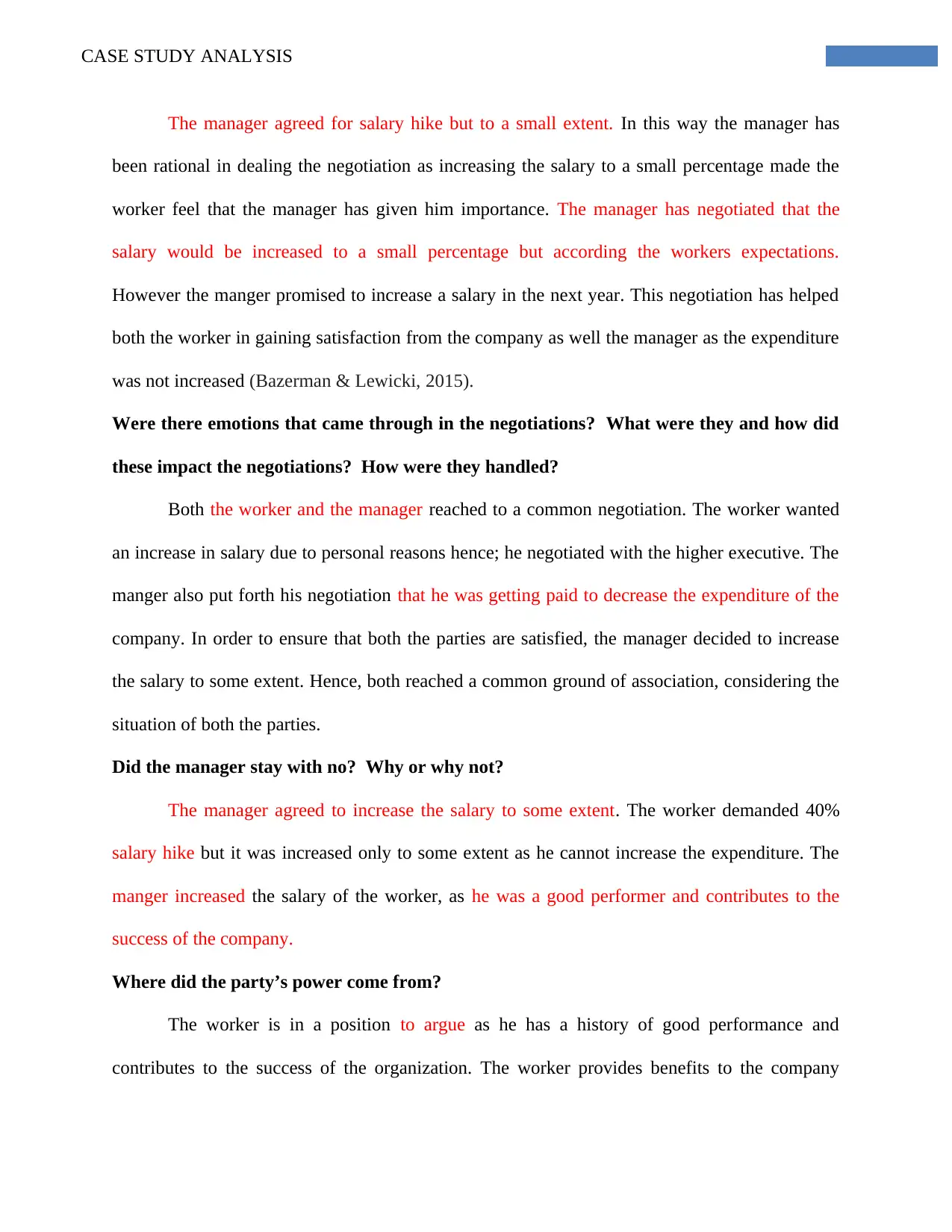
CASE STUDY ANALYSIS
The manager agreed for salary hike but to a small extent. In this way the manager has
been rational in dealing the negotiation as increasing the salary to a small percentage made the
worker feel that the manager has given him importance. The manager has negotiated that the
salary would be increased to a small percentage but according the workers expectations.
However the manger promised to increase a salary in the next year. This negotiation has helped
both the worker in gaining satisfaction from the company as well the manager as the expenditure
was not increased (Bazerman & Lewicki, 2015).
Were there emotions that came through in the negotiations? What were they and how did
these impact the negotiations? How were they handled?
Both the worker and the manager reached to a common negotiation. The worker wanted
an increase in salary due to personal reasons hence; he negotiated with the higher executive. The
manger also put forth his negotiation that he was getting paid to decrease the expenditure of the
company. In order to ensure that both the parties are satisfied, the manager decided to increase
the salary to some extent. Hence, both reached a common ground of association, considering the
situation of both the parties.
Did the manager stay with no? Why or why not?
The manager agreed to increase the salary to some extent. The worker demanded 40%
salary hike but it was increased only to some extent as he cannot increase the expenditure. The
manger increased the salary of the worker, as he was a good performer and contributes to the
success of the company.
Where did the party’s power come from?
The worker is in a position to argue as he has a history of good performance and
contributes to the success of the organization. The worker provides benefits to the company
The manager agreed for salary hike but to a small extent. In this way the manager has
been rational in dealing the negotiation as increasing the salary to a small percentage made the
worker feel that the manager has given him importance. The manager has negotiated that the
salary would be increased to a small percentage but according the workers expectations.
However the manger promised to increase a salary in the next year. This negotiation has helped
both the worker in gaining satisfaction from the company as well the manager as the expenditure
was not increased (Bazerman & Lewicki, 2015).
Were there emotions that came through in the negotiations? What were they and how did
these impact the negotiations? How were they handled?
Both the worker and the manager reached to a common negotiation. The worker wanted
an increase in salary due to personal reasons hence; he negotiated with the higher executive. The
manger also put forth his negotiation that he was getting paid to decrease the expenditure of the
company. In order to ensure that both the parties are satisfied, the manager decided to increase
the salary to some extent. Hence, both reached a common ground of association, considering the
situation of both the parties.
Did the manager stay with no? Why or why not?
The manager agreed to increase the salary to some extent. The worker demanded 40%
salary hike but it was increased only to some extent as he cannot increase the expenditure. The
manger increased the salary of the worker, as he was a good performer and contributes to the
success of the company.
Where did the party’s power come from?
The worker is in a position to argue as he has a history of good performance and
contributes to the success of the organization. The worker provides benefits to the company
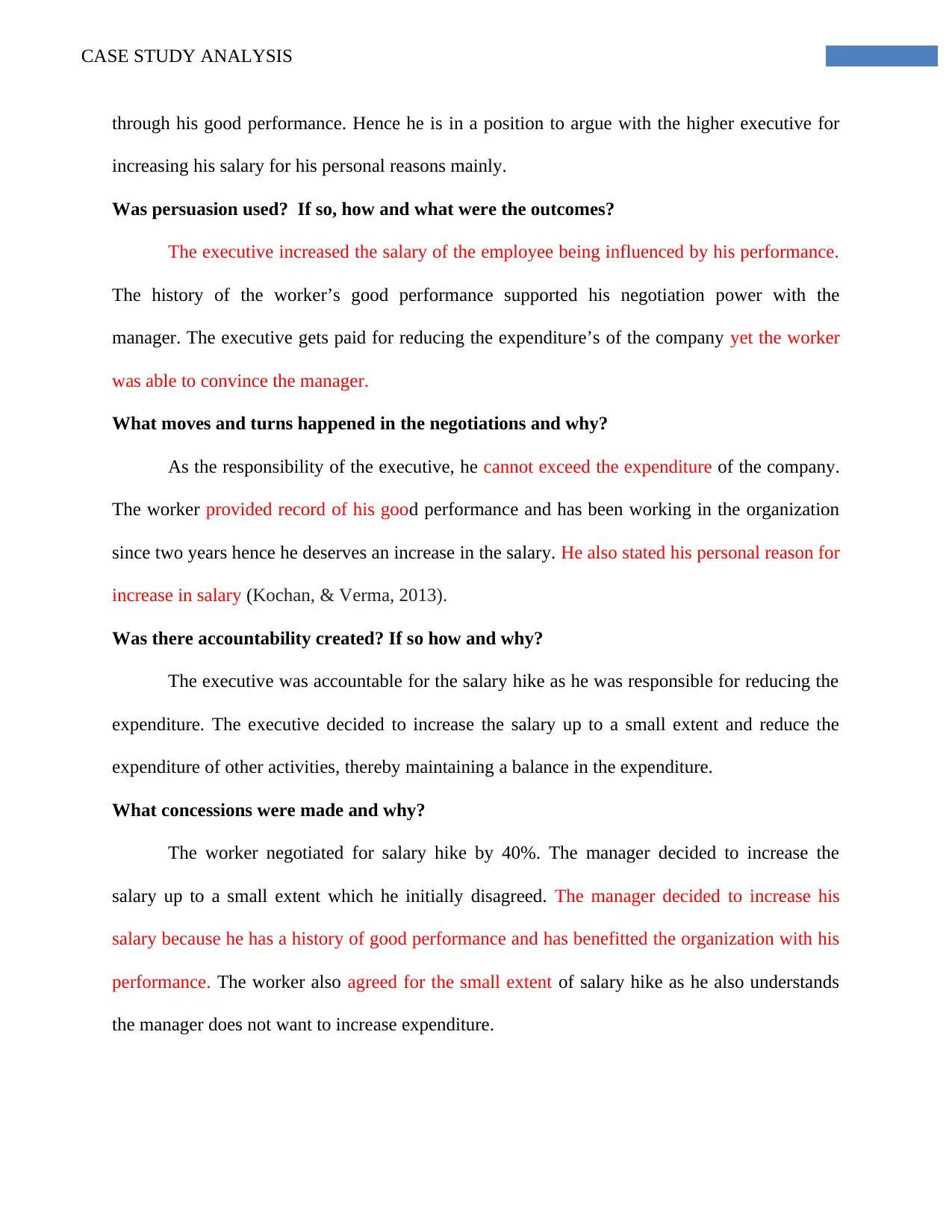
CASE STUDY ANALYSIS
through his good performance. Hence he is in a position to argue with the higher executive for
increasing his salary for his personal reasons mainly.
Was persuasion used? If so, how and what were the outcomes?
The executive increased the salary of the employee being influenced by his performance.
The history of the worker’s good performance supported his negotiation power with the
manager. The executive gets paid for reducing the expenditure’s of the company yet the worker
was able to convince the manager.
What moves and turns happened in the negotiations and why?
As the responsibility of the executive, he cannot exceed the expenditure of the company.
The worker provided record of his good performance and has been working in the organization
since two years hence he deserves an increase in the salary. He also stated his personal reason for
increase in salary (Kochan, & Verma, 2013).
Was there accountability created? If so how and why?
The executive was accountable for the salary hike as he was responsible for reducing the
expenditure. The executive decided to increase the salary up to a small extent and reduce the
expenditure of other activities, thereby maintaining a balance in the expenditure.
What concessions were made and why?
The worker negotiated for salary hike by 40%. The manager decided to increase the
salary up to a small extent which he initially disagreed. The manager decided to increase his
salary because he has a history of good performance and has benefitted the organization with his
performance. The worker also agreed for the small extent of salary hike as he also understands
the manager does not want to increase expenditure.
through his good performance. Hence he is in a position to argue with the higher executive for
increasing his salary for his personal reasons mainly.
Was persuasion used? If so, how and what were the outcomes?
The executive increased the salary of the employee being influenced by his performance.
The history of the worker’s good performance supported his negotiation power with the
manager. The executive gets paid for reducing the expenditure’s of the company yet the worker
was able to convince the manager.
What moves and turns happened in the negotiations and why?
As the responsibility of the executive, he cannot exceed the expenditure of the company.
The worker provided record of his good performance and has been working in the organization
since two years hence he deserves an increase in the salary. He also stated his personal reason for
increase in salary (Kochan, & Verma, 2013).
Was there accountability created? If so how and why?
The executive was accountable for the salary hike as he was responsible for reducing the
expenditure. The executive decided to increase the salary up to a small extent and reduce the
expenditure of other activities, thereby maintaining a balance in the expenditure.
What concessions were made and why?
The worker negotiated for salary hike by 40%. The manager decided to increase the
salary up to a small extent which he initially disagreed. The manager decided to increase his
salary because he has a history of good performance and has benefitted the organization with his
performance. The worker also agreed for the small extent of salary hike as he also understands
the manager does not want to increase expenditure.
Secure Best Marks with AI Grader
Need help grading? Try our AI Grader for instant feedback on your assignments.
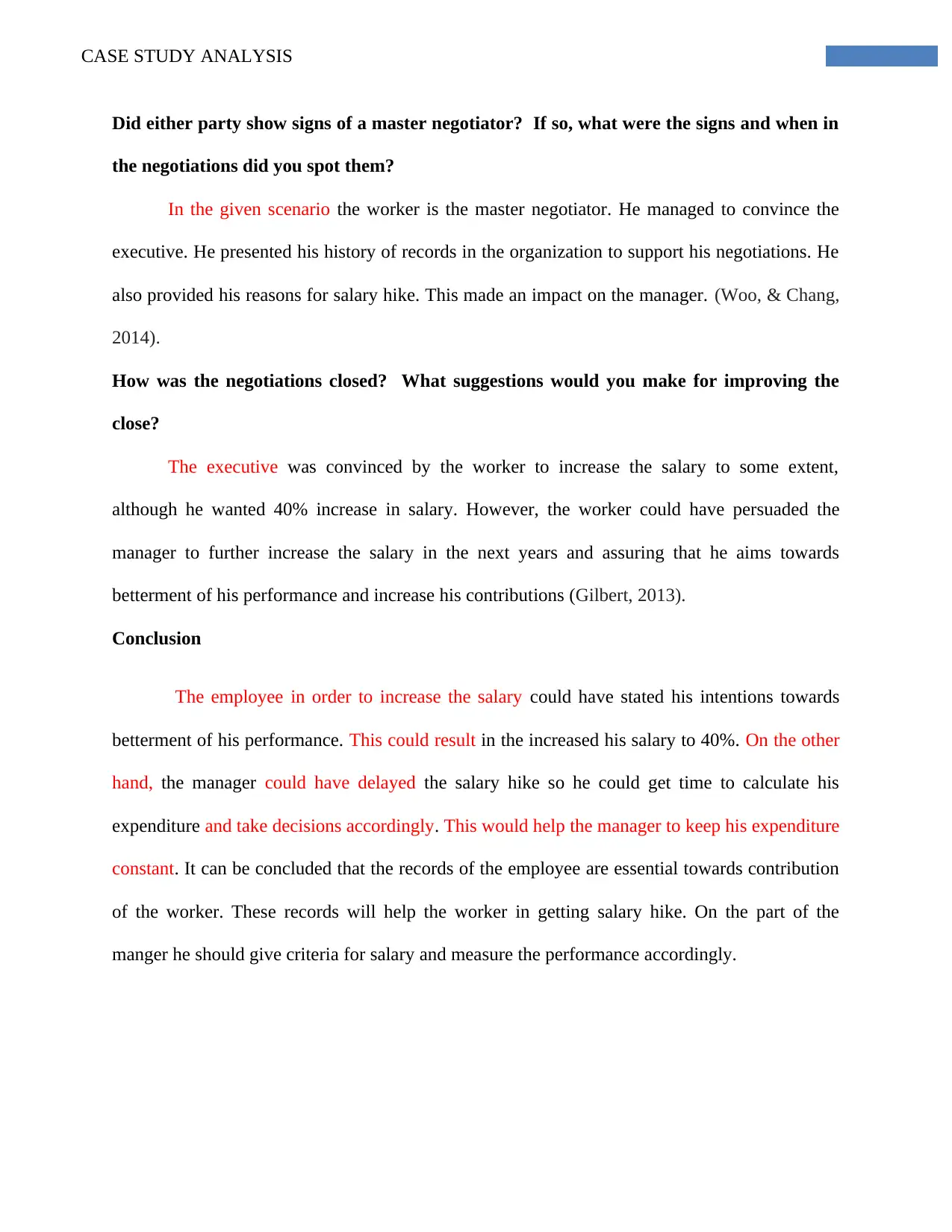
CASE STUDY ANALYSIS
Did either party show signs of a master negotiator? If so, what were the signs and when in
the negotiations did you spot them?
In the given scenario the worker is the master negotiator. He managed to convince the
executive. He presented his history of records in the organization to support his negotiations. He
also provided his reasons for salary hike. This made an impact on the manager. (Woo, & Chang,
2014).
How was the negotiations closed? What suggestions would you make for improving the
close?
The executive was convinced by the worker to increase the salary to some extent,
although he wanted 40% increase in salary. However, the worker could have persuaded the
manager to further increase the salary in the next years and assuring that he aims towards
betterment of his performance and increase his contributions (Gilbert, 2013).
Conclusion
The employee in order to increase the salary could have stated his intentions towards
betterment of his performance. This could result in the increased his salary to 40%. On the other
hand, the manager could have delayed the salary hike so he could get time to calculate his
expenditure and take decisions accordingly. This would help the manager to keep his expenditure
constant. It can be concluded that the records of the employee are essential towards contribution
of the worker. These records will help the worker in getting salary hike. On the part of the
manger he should give criteria for salary and measure the performance accordingly.
Did either party show signs of a master negotiator? If so, what were the signs and when in
the negotiations did you spot them?
In the given scenario the worker is the master negotiator. He managed to convince the
executive. He presented his history of records in the organization to support his negotiations. He
also provided his reasons for salary hike. This made an impact on the manager. (Woo, & Chang,
2014).
How was the negotiations closed? What suggestions would you make for improving the
close?
The executive was convinced by the worker to increase the salary to some extent,
although he wanted 40% increase in salary. However, the worker could have persuaded the
manager to further increase the salary in the next years and assuring that he aims towards
betterment of his performance and increase his contributions (Gilbert, 2013).
Conclusion
The employee in order to increase the salary could have stated his intentions towards
betterment of his performance. This could result in the increased his salary to 40%. On the other
hand, the manager could have delayed the salary hike so he could get time to calculate his
expenditure and take decisions accordingly. This would help the manager to keep his expenditure
constant. It can be concluded that the records of the employee are essential towards contribution
of the worker. These records will help the worker in getting salary hike. On the part of the
manger he should give criteria for salary and measure the performance accordingly.
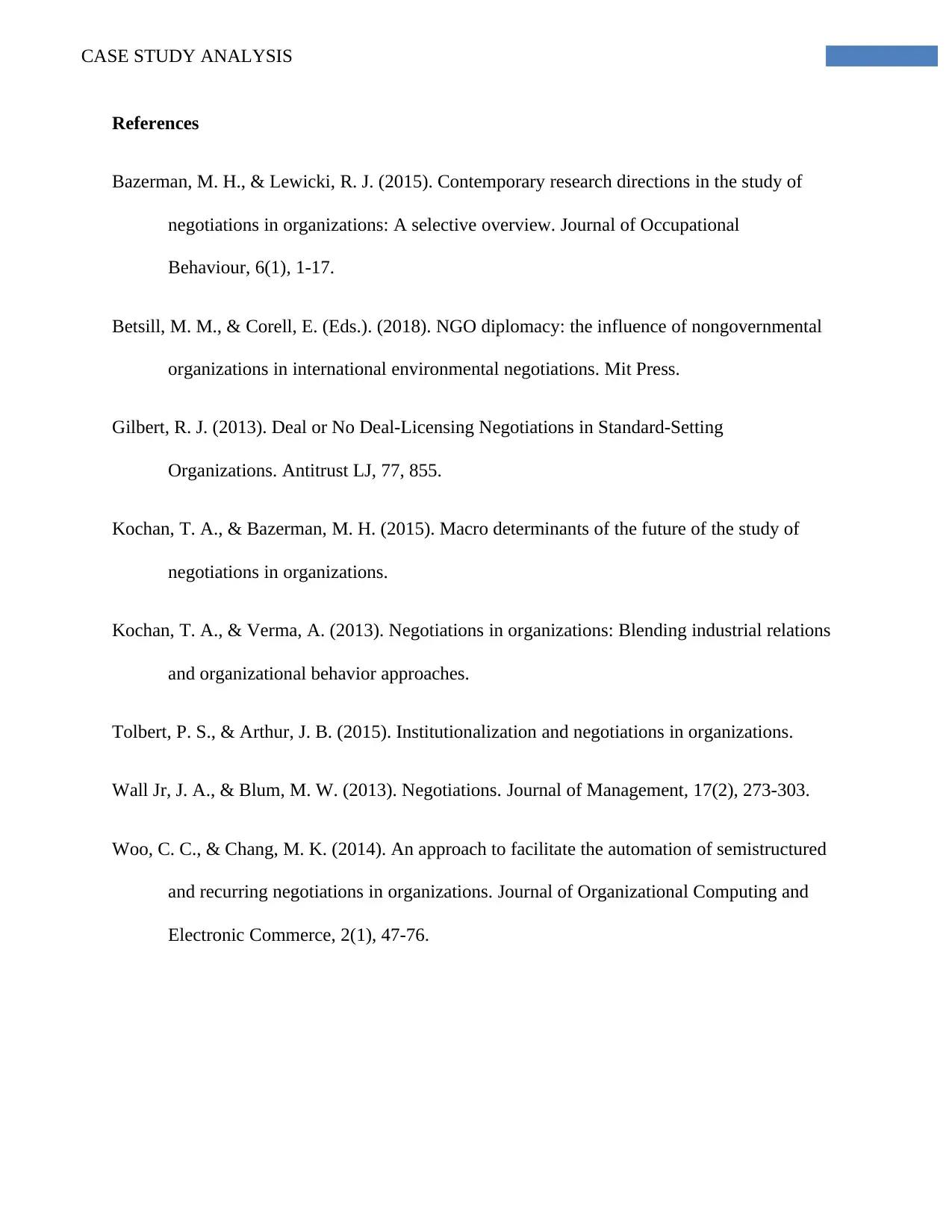
CASE STUDY ANALYSIS
References
Bazerman, M. H., & Lewicki, R. J. (2015). Contemporary research directions in the study of
negotiations in organizations: A selective overview. Journal of Occupational
Behaviour, 6(1), 1-17.
Betsill, M. M., & Corell, E. (Eds.). (2018). NGO diplomacy: the influence of nongovernmental
organizations in international environmental negotiations. Mit Press.
Gilbert, R. J. (2013). Deal or No Deal-Licensing Negotiations in Standard-Setting
Organizations. Antitrust LJ, 77, 855.
Kochan, T. A., & Bazerman, M. H. (2015). Macro determinants of the future of the study of
negotiations in organizations.
Kochan, T. A., & Verma, A. (2013). Negotiations in organizations: Blending industrial relations
and organizational behavior approaches.
Tolbert, P. S., & Arthur, J. B. (2015). Institutionalization and negotiations in organizations.
Wall Jr, J. A., & Blum, M. W. (2013). Negotiations. Journal of Management, 17(2), 273-303.
Woo, C. C., & Chang, M. K. (2014). An approach to facilitate the automation of semistructured
and recurring negotiations in organizations. Journal of Organizational Computing and
Electronic Commerce, 2(1), 47-76.
References
Bazerman, M. H., & Lewicki, R. J. (2015). Contemporary research directions in the study of
negotiations in organizations: A selective overview. Journal of Occupational
Behaviour, 6(1), 1-17.
Betsill, M. M., & Corell, E. (Eds.). (2018). NGO diplomacy: the influence of nongovernmental
organizations in international environmental negotiations. Mit Press.
Gilbert, R. J. (2013). Deal or No Deal-Licensing Negotiations in Standard-Setting
Organizations. Antitrust LJ, 77, 855.
Kochan, T. A., & Bazerman, M. H. (2015). Macro determinants of the future of the study of
negotiations in organizations.
Kochan, T. A., & Verma, A. (2013). Negotiations in organizations: Blending industrial relations
and organizational behavior approaches.
Tolbert, P. S., & Arthur, J. B. (2015). Institutionalization and negotiations in organizations.
Wall Jr, J. A., & Blum, M. W. (2013). Negotiations. Journal of Management, 17(2), 273-303.
Woo, C. C., & Chang, M. K. (2014). An approach to facilitate the automation of semistructured
and recurring negotiations in organizations. Journal of Organizational Computing and
Electronic Commerce, 2(1), 47-76.
1 out of 6
Related Documents
Your All-in-One AI-Powered Toolkit for Academic Success.
+13062052269
info@desklib.com
Available 24*7 on WhatsApp / Email
![[object Object]](/_next/static/media/star-bottom.7253800d.svg)
Unlock your academic potential
© 2024 | Zucol Services PVT LTD | All rights reserved.




